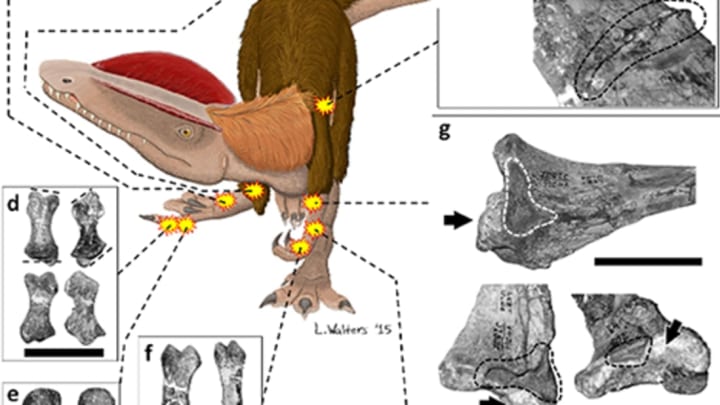Move over, T. rex: There's a new toughest dinosaur in town. One specimen of Dilophosaurus (portrayed in Jurassic Park—inaccurately—as a venom-spitting dino with a neck frill) survived a record-breaking eight bone injuries in its front limbs and shoulder.
The predatory dino must have muscled through a world of pain and a period when its front left limb was useless for capturing prey. Phil Senter, a paleontologist at Fayetteville State University in North Carolina, found the injuries by examining the skeleton at the University of California Museum of Paleontology in Berkeley and published the results in PLOS One.
The skeleton of the Dilophosaurus wetherilli was first discovered in 1942 and described in 1954 by paleontologist Sam Welles, who mentioned only a single finger injury. At the time, paleontologists often didn’t report injuries. Today, diagnosing injuries, disease, or illness from fossil evidence, called paleopathology, can teach us a lot about dinosaur biology and behavior, New Mexico Museum of Natural History and Science paleontologist Spencer Lucas tells mental_floss.
This particular unfortunate dinosaur had four wounds on its left side: a broken shoulder blade, a broken radius (lower arm bone), and gaping holes in its thumb bone and ulna (the other lower arm bone). Both of these holes probably came from infections after a puncture wound. Senter found no tooth marks on the bones, so he thinks the punctures were from a kick—maybe from prey or a rival.
On the right side, the dinosaur had three bony tumors on its lower arm bone, and three misshapen bones in its upper arm and finger. The twisted bones fit perfectly together, so Senter thinks that the animal favored its right side after its injuries, potentially bending the bones, which were already softened by malnutrition. He found similar conditions in modern birds. This is the first time developmental osteodysplasia, or abnormal formation of the bone, has been spotted in a non-avian dinosaur, the researchers write.

The hand of the D. wetherilli specimen known as UCMP 37302 in full flexion, showing pathological orientation of the phalanges of finger III. Note that the third finger is abnormally angled in two places: at the metacarpophalangeal joint and at the first interphalangeal joint. Bones with broken outlines are missing from the right hand and are reconstructed according to their shapes in the left hand. Image credit: Senter et al. in PLOS One
Senter doesn’t know what caused the injuries, but they could have plausibly all come from the same accident. “I would not be surprised if, say, it got a kick from a rival, accounting for the puncture wounds, and in the process got slammed into something, accounting for the breaks,” Senter tells mental_floss. “There’s no way to tell for sure, but it makes a nice story anyway.”
What he does know, because of how smooth the injured bones were, is that the animal healed from its injuries. The healing would have taken at least a few weeks, and how the predator survived is a mystery. It could have eaten very small prey, says Senter, or perhaps carrion, “a free meal without a struggle.”
“It toughed it out,” Lucas speculates. “When you’re a wild animal, you don’t exactly get health care.”
Senter and Lucas agree that reexamining other dinosaur fossils will likely yield more new insights like this one. Even this Dilophosaurus might have more injuries—Senter only had time to examine the front limbs, shoulders, and feet. “People like the authors of this paper are looking at the fossils with different eyes,” says Lucas.
